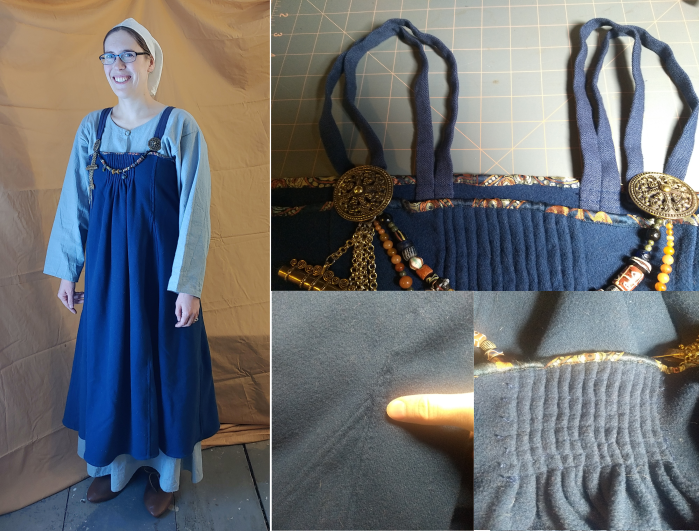Materials: wool garment with linen loops and silk edging. Linen, silk, and cotton thread.
Techniques: Hand-sewn throughout with period stitches. Pleating.
Documentation: https://docs.google.com/document/d/1elhdMzJ5R89Qf5G4w-XKOYhyPukk8ywKDtTv3_DAxCc/edit
EK Wiki: https://wiki.eastkingdom.org/wiki/Guðrún_Sveinsdóttir
I chose this project because I needed a warm winter smokkr. I was inspired largely by the pleated smokkr fragments found at Køstrup, with further construction techniques and materials inspired by other Viking-era Scandinavian finds. My goal was to create a practical piece of garb using period techniques and materials as much as possible.
All materials are 100% their stated fiber content; I did not use any blends. This was for two reasons: 1) historical accuracy, and 2) pure fibers act differently than blends in sewing, draping, and washing. I prefer working with natural fibers in general, and wanted to be able to count on the properties of the various fibers without the surprises (like uneven shrinkage, etc.) that can come with blends. I also decided that this would be my first large piece of garb that is entirely hand-sewn, for both of those same reasons. I used only period-accurate stitches: overcast/whip stitch, running stitch, and back stitch. I find that hand-sewing also allows more on-the-spot fixes and adjustments, and the finished seams tend to lie flatter and be less visually obtrusive, especially where several seams come together (e.g. the points of the side gores). Hand-sewing such a large garment posed a challenge, as I have tendonitis in my thumbs and forearms, but with careful management, I was able to complete the project. The only material I used that would not have been likely in Viking-era Scandinavia was the cotton thread I used to whip-stitch the edges of the linen straps. At the time I sewed the straps, I did not have the linen thread and my alternative was polyester, so it was a practical consideration.
The Køstrup, Denmark, find of a pleated wool smokkr is dated to 850-860 CE (Delvaux, 2017). There is also archaeological evidence for pleated smokkrs in finds from the Viking-era trading center of Kaupang, Grave C, dated to 850-900 CE (Ingstad, 1979); and Grave B 5625 in Vangsnes (Holm-Olsen, 1976). Both sites are in Norway. My coat-weight felted wool is a heavier weight than the original find, but good for my purposes of keeping warm. The blue I chose is a color that would be possible to achieve with woad, and the extant find was also blue (Rasmussen & Lønborg, 1993). I made my pleats as small as possible; they are close to the Kaupang find in size. Mine also worked best as knife pleats to reduce bulk. The original pleating appears to be vertically gathered, creating more rounded pleats (Rasmussen and Lønborg, 1993), but that was not a feasible technique for my very thick fabric. A 14th-century find, Grave 33 in Uvdal, Norway, shows pleating with linen thread still extant, running through the pleats and then joined with seams around the back to stabilize the pleats (Vedeler, 2007, p. 3). I believe this interpretation could be plausible for my persona. Due to the back-stitched/overcast stabilizing threads, my pleated section is fairly firm, but still semi-flexible. I chose to use linen for my straps to reduce the bulk that thick wool straps would create. Grave 597 at Birka showed linen loops on a wool smokkr (Hägg, 1974). My linen fabric is a woad-like dark blue, since woad is one of the very few dyes that linen will tolerate. To finish the top hem, I chose to use some thin strips of reproduction 9th/10th century Byzantine silk as a binding: a similar technique to using modern bias tape, although these strips are straight-grain as they would have been in period. Birka Graves 464, 834, and 835 all have fragments of narrow silk binding that may have been attached to the top edge of wool smokkrs (Geijer, 1938). The bottom hem is a double-fold hem that I overcast/hem-stitched, to cover all raw edges. This has strong archaeological evidence as a period technique, including finds at Hedeby (Hägg, 1984).
I am pleased with the warmth of the final garment, and for the most part, the look. The pleating combined with the thickness of my chosen wool does lend itself to the dress belling out over the stomach in a way that modern fashion usually avoids, with the exception of maternity clothes. However, I enjoy the look of the pleating itself and the back shaping, and the silk binding gives a nice pop of color that will also match the silk trim on my coat. I may decide to modify the bottom hem to reduce bulk, but I need to do more research to choose which technique I would like to try. I learned a lot throughout this journey, and I am proud that I tried new techniques and hand-sewed the entire dress. I look forward to wearing this smokkr to winter events in the future!

Great work! This is an interesting interpretation of this style.
I love the pleating and the color, and the adaptation appears to be internally consistent. Good stuff.
This is really really beautiful and I particularly loved your pleating explanation and your whole step by step construction. The wool looks lush and warm too!
Freeholder!!!
I enjoyed your careful and thorough documentation, and your successful finished project really has the look of an authentic period garment to me. Beautiful work, and I hope you are warm now!
Your garment looks lovely and I love how much detail you included in your quick write up